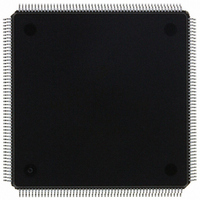MCF5307AI90B Freescale Semiconductor, MCF5307AI90B Datasheet - Page 327

MCF5307AI90B
Manufacturer Part Number
MCF5307AI90B
Description
IC MPU 32BIT COLDF 90MHZ 208FQFP
Manufacturer
Freescale Semiconductor
Series
MCF530xr
Datasheets
1.MCF5307AI66B.pdf
(484 pages)
2.MCF5307AI66B.pdf
(16 pages)
3.MCF5307AI66B.pdf
(2 pages)
Specifications of MCF5307AI90B
Core Processor
Coldfire V3
Core Size
32-Bit
Speed
90MHz
Connectivity
EBI/EMI, I²C, UART/USART
Peripherals
DMA, POR, WDT
Number Of I /o
16
Program Memory Type
ROMless
Ram Size
4K x 8
Voltage - Supply (vcc/vdd)
3 V ~ 3.6 V
Oscillator Type
External
Operating Temperature
0°C ~ 70°C
Package / Case
208-FQFP
Maximum Clock Frequency
90 MHz
Maximum Operating Temperature
+ 105 C
Mounting Style
SMD/SMT
Minimum Operating Temperature
0 C
Family Name
MCF5xxx
Device Core
ColdFire
Device Core Size
32b
Frequency (max)
90MHz
Instruction Set Architecture
RISC
Supply Voltage 1 (typ)
3.3V
Operating Temp Range
0C to 70C
Operating Temperature Classification
Commercial
Mounting
Surface Mount
Pin Count
208
Package Type
FQFP
Program Memory Size
8KB
Cpu Speed
90MHz
Embedded Interface Type
I2C, UART
Digital Ic Case Style
FQFP
No. Of Pins
208
Supply Voltage Range
3V To 3.6V
Rohs Compliant
Yes
Lead Free Status / RoHS Status
Lead free / RoHS Compliant
Eeprom Size
-
Program Memory Size
-
Data Converters
-
Lead Free Status / Rohs Status
Lead free / RoHS Compliant
Available stocks
Company
Part Number
Manufacturer
Quantity
Price
Company:
Part Number:
MCF5307AI90B
Manufacturer:
FREESCAL
Quantity:
153
Company:
Part Number:
MCF5307AI90B
Manufacturer:
Freescale Semiconductor
Quantity:
10 000
Part Number:
MCF5307AI90B
Manufacturer:
FREESCALE
Quantity:
20 000
- Current page: 327 of 484
- Download datasheet (6Mb)
The interrupt level, priority, and auto-vectoring capability is programmed in SIM register
ICR4 for UART0 and ICR5 for UART1. See Section 9.2.1, “Interrupt Control Registers
(ICR0–ICR9).”
Note that the UARTs can also automatically transfer data by using the DMA rather than
interrupting the core. When UIMR[FFULL] is 1 and a receiver’s FIFO is full, it can send
an interrupt to a DMA channel so the FIFO data can be transferred to memory. Note also
that UART0 and UART1’s interrupt requests are connected to DMA channel 2 and
channel 3, respectively.
Table 14-13 briefly describes the UART module signals.
Figure 14-18 shows a signal configuration for a UART/RS-232 interface.
Transmitter
Serial Data
Output (TxD)
Receiver
Serial Data
Input (RxD)
Clear-to-
Send (CTS)
Request-to-
Send (RTS)
Signal
TxD is held high (mark condition) when the transmitter is disabled, idle, or operating in the local
loop-back mode. Data is shifted out on TxD on the falling edge of the clock source, with the least
significant bit (lsb) sent first.
Data received on RxD is sampled on the rising edge of the clock source, with the lsb received first.
This input can generate an interrupt on a change of state.
This output can be programmed to be negated or asserted automatically by either the receiver or the
transmitter. When connected to a transmitter’s CTS, RTS can control serial data flow.
The terms ‘assertion’ and ‘negation’ are used to avoid
confusion between active-low and active-high signals.
‘Asserted’ indicates that a signal is active, independent of the
voltage level; ‘negated’ indicates that a signal is inactive.
Freescale Semiconductor, Inc.
Figure 14-18. UART/RS-232 Interface
For More Information On This Product,
Table 14-13. UART Module Signals
UART
CTS
RTS
RxD
TxD
Chapter 14. UART Modules
Go to: www.freescale.com
NOTE:
Description
RS-232 Transceiver
DI2
DO2
DI1
DO1
UART Module Signal Definitions
14-17
Related parts for MCF5307AI90B
Image
Part Number
Description
Manufacturer
Datasheet
Request
R
Part Number:
Description:
Manufacturer:
Freescale Semiconductor, Inc
Datasheet:
Part Number:
Description:
Mcf5307 Coldfire Integrated Microprocessor User
Manufacturer:
Freescale Semiconductor, Inc
Datasheet:
Part Number:
Description:
Manufacturer:
Freescale Semiconductor, Inc
Datasheet:
Part Number:
Description:
Manufacturer:
Freescale Semiconductor, Inc
Datasheet:
Part Number:
Description:
Manufacturer:
Freescale Semiconductor, Inc
Datasheet:
Part Number:
Description:
Manufacturer:
Freescale Semiconductor, Inc
Datasheet:
Part Number:
Description:
Manufacturer:
Freescale Semiconductor, Inc
Datasheet:
Part Number:
Description:
Manufacturer:
Freescale Semiconductor, Inc
Datasheet:
Part Number:
Description:
Manufacturer:
Freescale Semiconductor, Inc
Datasheet:
Part Number:
Description:
Manufacturer:
Freescale Semiconductor, Inc
Datasheet:
Part Number:
Description:
Manufacturer:
Freescale Semiconductor, Inc
Datasheet:
Part Number:
Description:
Manufacturer:
Freescale Semiconductor, Inc
Datasheet:
Part Number:
Description:
Manufacturer:
Freescale Semiconductor, Inc
Datasheet:
Part Number:
Description:
Manufacturer:
Freescale Semiconductor, Inc
Datasheet:
Part Number:
Description:
Manufacturer:
Freescale Semiconductor, Inc
Datasheet:











